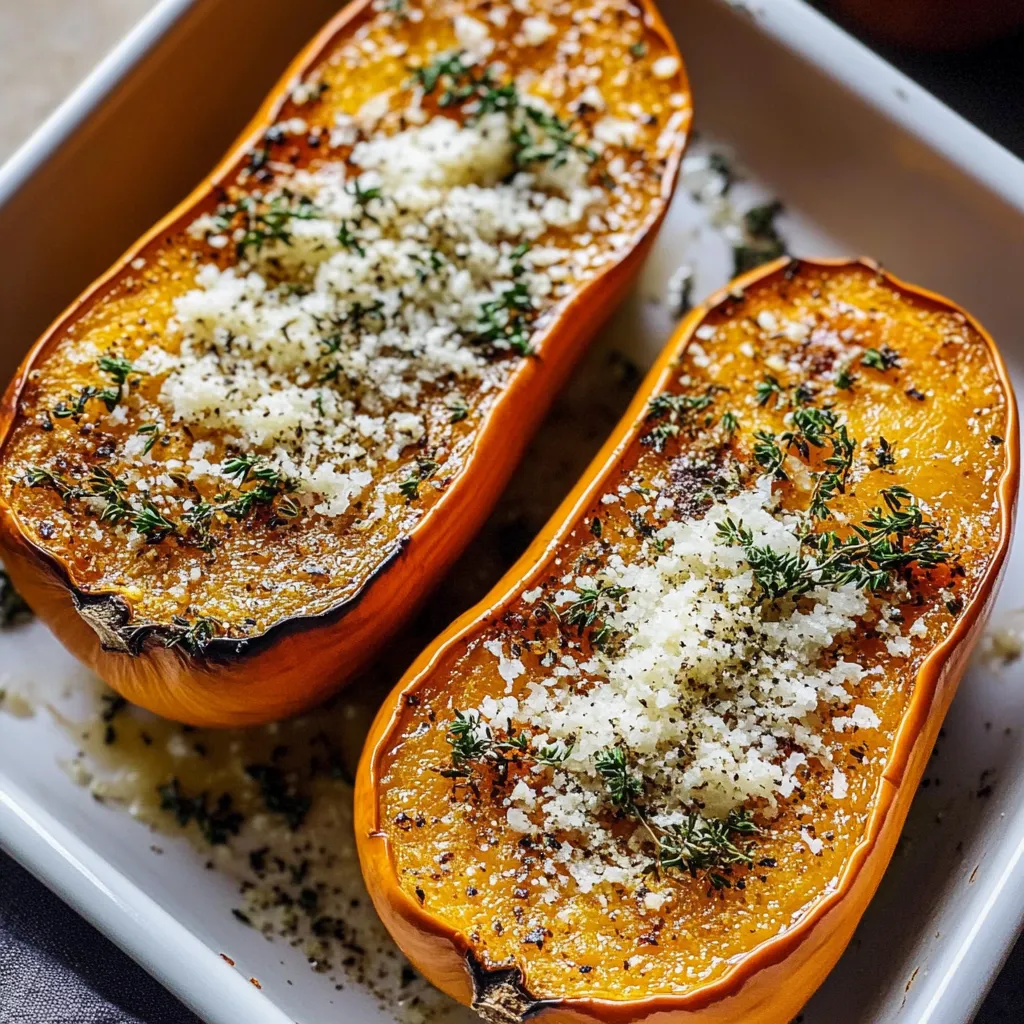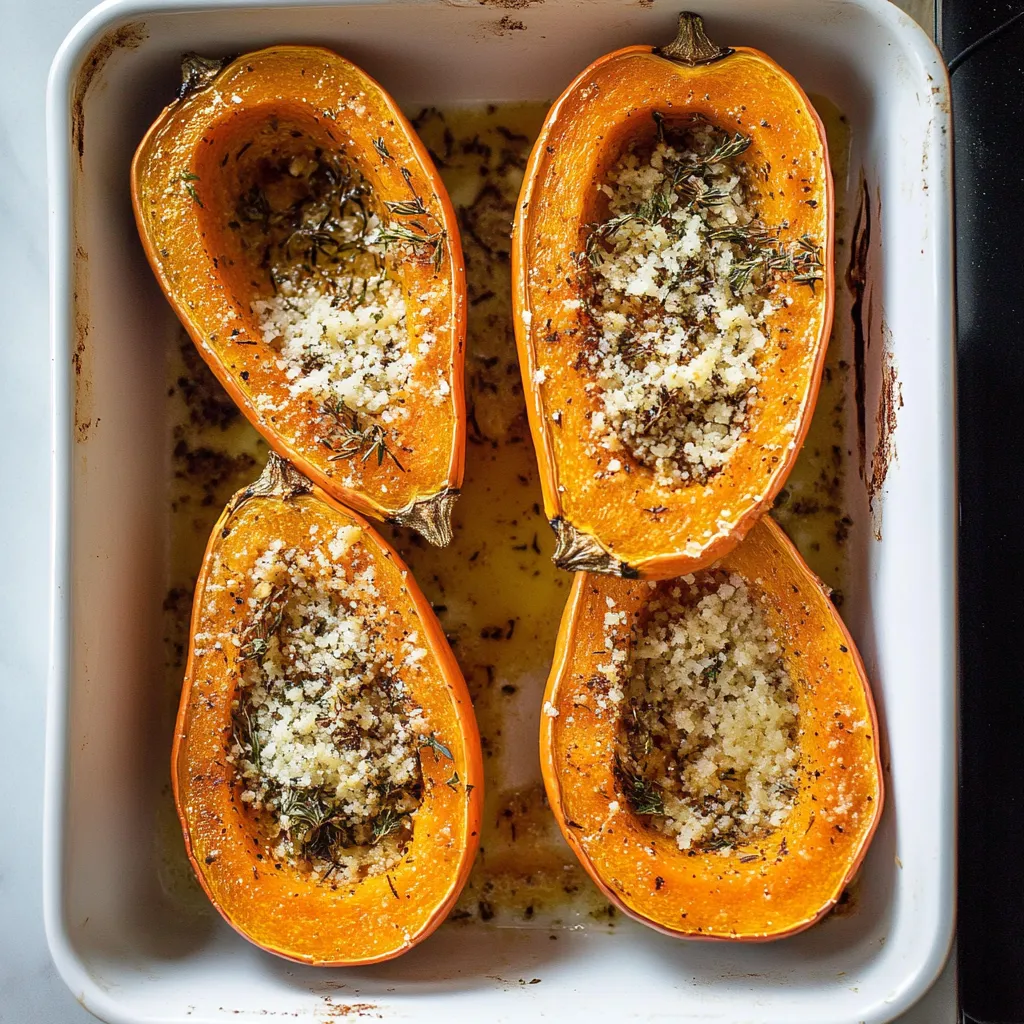 Pin it
Pin it
This roasted honeynut squash showcases the natural sweetness of these adorable mini squashes while savory herbs and Parmesan cheese create a perfectly balanced side dish that's both comforting and sophisticated. Simply halved, seasoned with aromatic thyme, rosemary, and garlic, then roasted until caramelized and tender, these little gems require minimal prep but deliver maximum flavor and visual appeal. The edible skin makes preparation incredibly easy while the concentrated sweetness and vibrant orange color make them a standout addition to any fall or winter meal.
Why You'll Love This Recipe
I get genuinely excited every year when honeynut squashes appear in grocery stores because their season is so frustratingly short, but the results are absolutely worth seeking them out. Unlike the sweet maple syrup versions I see everywhere, I wanted to create something more savory that would work with a variety of main dishes while still letting that gorgeous natural sweetness shine through. The first time I made these, my family was amazed by how something so simple could taste so elegant and refined. Now they're a requested side dish whenever I can find the squashes, and I always buy extra to freeze for later in the season.
Ingredients
- Honeynut squashes (4-6 small squashes): Look for firm, heavy squashes with deep tan skin and no soft spots during their brief season
- Extra virgin olive oil (3 tablespoons): Helps the seasonings adhere while promoting beautiful browning and caramelization
- Dried thyme (1 teaspoon): Adds earthy, aromatic notes that complement the squash's natural sweetness perfectly
- Dried rosemary (1 teaspoon, crushed): Provides pine-like fragrance and robust flavor that stands up to roasting
- Garlic powder (1 teaspoon): Distributes evenly across the surface and adds savory depth without burning like fresh garlic might
- Freshly grated Parmesan cheese (1/2 cup): Use real Parmigiano-Reggiano for the best nutty, salty flavor that enhances the squash
- Salt and freshly ground black pepper: Season generously to bring out all the other flavors
- Fresh thyme sprigs (optional, for garnish): Adds beautiful color and fresh herbal aroma to the finished dish
Instructions
- Step 1:
- Preheat oven and prepare baking surface. Set your oven to 425°F and line a large baking sheet with parchment paper or lightly grease a baking dish large enough to hold all the squash halves in a single layer.
- Step 2:
- Prepare the honeynut squashes properly. Wash the squashes thoroughly, then cut each one in half lengthwise using a sharp knife. The skin can be tough, so work carefully and use a stable cutting board.
- Step 3:
- Remove seeds and create clean cavities. Using a spoon, scoop out all the seeds and stringy pulp from each squash half, creating smooth, clean cavities for the seasonings. Save the seeds for roasting if desired.
- Step 4:
- Brush with olive oil for optimal browning. Place the squash halves cut-side up on your prepared baking sheet and brush the exposed flesh generously with olive oil, making sure to coat the entire surface evenly.
- Step 5:
- Season with aromatic herbs and spices. Sprinkle each squash half evenly with thyme, crushed rosemary, garlic powder, salt, and pepper, using your fingers to gently press the seasonings into the flesh.
- Step 6:
- Add Parmesan cheese for golden finish. Distribute the grated Parmesan cheese evenly over each seasoned squash half, creating a generous layer that will melt and brown beautifully during roasting.
- Step 7:
- Roast until tender and caramelized. Bake for 30-35 minutes, until the squash flesh is completely tender when pierced with a fork and the tops are golden brown with lightly caramelized edges.
- Step 8:
- Check for doneness and perfect texture. The squash should be easily pierced with a fork, and the flesh should be creamy and sweet. If needed, continue roasting in 5-minute increments until properly tender.
- Step 9:
- Garnish and serve immediately. Remove from oven and let cool for 2-3 minutes, then garnish with fresh thyme sprigs if desired. Serve hot as a beautiful and delicious side dish.
 Pin it
Pin it
Understanding Honeynut Squash Characteristics
Honeynut squash is truly a special ingredient that deserves more recognition in home kitchens. These adorable mini squashes are actually a hybrid of butternut and buttercup squash, combining the best qualities of both parents. They're significantly sweeter than butternut squash while maintaining that familiar creamy texture, and their deep orange flesh indicates exceptionally high levels of beta-carotene.
The edible skin is what makes honeynut squash so much more convenient than butternut squash. You can simply halve them and roast without any peeling or difficult prep work. The skin becomes tender during roasting and adds both flavor and nutrition to the final dish, though it can easily be removed after cooking if preferred.
Achieving Perfect Roasting Results
The key to beautifully roasted honeynut squash lies in proper seasoning distribution and temperature control. The high heat of 425°F creates caramelization on the exposed surfaces while cooking the flesh evenly throughout. Brushing with olive oil is essential for preventing drying and helping the seasonings adhere properly.
The Parmesan cheese serves multiple purposes - it adds savory complexity, creates a beautiful golden crust, and helps protect the delicate flesh from drying out during the roasting process. The cheese should be nicely browned and slightly crispy when the squash is properly cooked.
Timing and Seasonal Availability
Honeynut squash has a frustratingly short season, typically appearing in stores from late September through early October. This brief window makes them a truly special seasonal treat that's worth seeking out when available. Many specialty grocery stores and farmers markets carry them during peak season.
If you can't find honeynut squash, butternut squash can be substituted, but you'll need to peel it and cut it into cubes rather than using the halving method. The cooking time may also need adjustment since butternut squash pieces will cook faster than whole honeynut halves.
Storage and Make-Ahead Options
Fresh honeynut squashes store well in a cool, dry place for several weeks, making them excellent for stocking up when you find them in stores. Once cooked, the roasted squash keeps beautifully in the refrigerator for up to four days and reheats well in the oven.
For advance preparation, you can halve and seed the squashes earlier in the day, then season and roast them just before serving. The roasted squash can also be made completely ahead and reheated in a 350°F oven until warmed through, though the texture is best when served fresh from the initial roasting.
Nutritional Benefits and Health Aspects
Honeynut squash is nutritionally superior to many other winter squashes, containing 2-3 times more beta-carotene than butternut squash. This powerful antioxidant converts to vitamin A in the body and supports immune function, eye health, and skin health. The deep orange color is a visual indicator of this exceptional nutritional density.
The squash is also an excellent source of fiber, potassium, and vitamin C while being naturally low in calories. The edible skin adds additional fiber and nutrients, making this a truly wholesome side dish that nourishes as well as satisfies.
Serving Suggestions and Meal Planning
These roasted honeynut squashes work beautifully as part of a complete autumn meal. Their natural sweetness pairs wonderfully with roasted meats like turkey, chicken, or pork, while the savory seasonings make them sophisticated enough for elegant dinner parties. They're substantial enough to serve as a vegetarian main course when paired with grains and greens.
For efficient meal planning, since you already have the oven running, consider roasting other vegetables or proteins at the same time. Brussels sprouts, carrots, or broccoli can all roast alongside the squash, while chicken thighs or salmon fillets can cook at the same temperature for a complete one-pan meal.
Creative Variations and Flavor Profiles
While this savory version is absolutely delicious as written, honeynut squash welcomes many different flavor combinations. For a Middle Eastern twist, try za'atar and olive oil with a drizzle of pomegranate molasses. Mexican-inspired versions work beautifully with cumin, chili powder, and lime juice.
For special occasions, consider stuffing the cavities with a mixture of wild rice, cranberries, and pecans for a more substantial side dish. The sweet-savory balance of honeynut squash works beautifully with both rustic and elegant flavor profiles.
You Must Know
I love how this recipe celebrates one of fall's most special but underutilized ingredients while proving that simple preparations often yield the most satisfying results. Every time I serve these adorable squashes, guests are charmed by their individual presentation and amazed by how sweet and flavorful they are. There's something so satisfying about working with seasonal ingredients at their peak, creating dishes that capture the essence of the season while nourishing both body and soul.
Professional Chef Tips
This roasted honeynut squash recipe represents everything I love about seasonal cooking - finding those special ingredients that are only available for a brief time and treating them with the respect and simplicity they deserve. Every time I make this dish, I'm reminded that some of the most memorable meals come from celebrating the natural flavors of peak-season produce rather than masking them with complicated preparations.
Frequently Asked Questions
- → How do I know when honeynut squash is done roasting?
- The squash is ready when you can easily pierce it with a fork and the top is golden brown. This usually takes about 35 minutes at 400°F.
- → Can I make this recipe without cheese?
- Yes! Simply skip the parmesan for a dairy-free version, or use your favorite plant-based cheese substitute instead.
- → What's the difference between honeynut and butternut squash?
- Honeynut squash is smaller and sweeter than butternut squash, with a more concentrated flavor. It's perfect for individual servings.
- → How should I store leftover roasted squash?
- Keep leftovers in the fridge for up to 3 days in an airtight container. Reheat in the microwave or oven until warmed through.
- → Can I use fresh herbs instead of dried?
- Absolutely! Use about double the amount of fresh thyme and rosemary, and chop them finely before sprinkling on the squash.
- → What goes well with roasted honeynut squash?
- This pairs great with roasted chicken, grilled salmon, or any protein. Add some greens or steamed vegetables for a complete meal.
